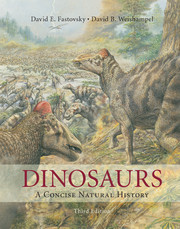Description
Dinosaurs (3rd Ed.)
A Concise Natural History
Authors: Fastovsky David E., Weishampel David B.
Language: English
Subject for Dinosaurs:
Approximative price 130.18 €
In Print (Delivery period: 14 days).
Add to cart
Publication date: 11-2016
Support: Print on demand
Support: Print on demand
Description
/li>Contents
/li>Biography
/li>
The ideal textbook for non-science majors, this lively and engaging introduction encourages students to ask questions, assess data critically and think like a scientist. Building on the success of the previous editions, Dinosaurs has been reorganised and extensively rewritten in response to instructor and student feedback. It continues to make science accessible and relevant through its clear explanations and extensive illustrations. Updated to reflect recent fossil discoveries and to include new taxa, the text guides students through the dinosaur groups, emphasising scientific concepts rather than presenting endless facts. It is grounded in the common language of modern evolutionary biology - phylogenetic systematics - so that students examine dinosaurs as professional paleontologists do. The key emerging theme of feathered dinosaurs, and the many implications of feathers, have been integrated throughout the book, highlighted by the inclusion of stunning new photographs in this beautifully illustrated text, now in full colour throughout.
Part I. Remembrance of Things Past: 1. To catch a dinosaur; 2. Dinosaur days; 3. Who's related to whom - and how do we know?; 4. Who are the dinosaurs?; 5. Dinosaurs: in the beginning; Part II. Saurischia: Meat, Might and Magnitude: 6. Theropoda I: nature red in tooth and claw; 7. Theropoda II: meet the theropods; 8. Theropoda III: the origin and early evolution of birds; 9. Sauropodomorpha: the big, the bizarre, and the majestic; Part III. Ornithischia: Armored, Horned, and Duck-Billed Dinosaur: 10. Thyreophorans: the armor-bearers; 11. Marginocephalia: bumps, bosses, and beaks; 12. Ornithopoda: mighty masticators of the Mesozoic; Part IV. Endothermy, Endemism, and Extinction: 13. Dinosaur thermoregulation: some like it hot; 14. The flowering of the Mesozoic; 15. A history of paleontology through ideas; 16. The Cretaceous-Tertiary extinction: the frill is gone; Glossary; Index of subjects; Index of genera.
David E. Fastovsky is Professor and Chair of the Department of Geosciences at the University of Rhode Island. His interest in dinosaurs began in his early years when he read about a paleontologist's adventures in the Gobi Desert early in the twentieth century. He has carried out fieldwork all over the world. He is known as a dynamic teacher as well as a respected researcher on the environments in which dinosaurs roamed, as well as their extinction.
David B. Weishampel is Professor at the Center for Functional Anatomy and Evolution at Johns Hopkins University School of Medicine. His research focuses on dinosaur evolution and how dinosaurs function, and he is particularly interested in herbivorous dinosaurs and the dinosaur record of Europe. He is senior editor of The Dinosauria and has contributed to a number of popular publications, including acting as consultant to Michael Crichton in the writing of The Lost World, the inspiration for Steven Spielberg's film Jurassic Park. He was recently honoured in an International Symposium on duck-billled dinosaurs, dedicated to him and his research.
David B. Weishampel is Professor at the Center for Functional Anatomy and Evolution at Johns Hopkins University School of Medicine. His research focuses on dinosaur evolution and how dinosaurs function, and he is particularly interested in herbivorous dinosaurs and the dinosaur record of Europe. He is senior editor of The Dinosauria and has contributed to a number of popular publications, including acting as consultant to Michael Crichton in the writing of The Lost World, the inspiration for Steven Spielberg's film Jurassic Park. He was recently honoured in an International Symposium on duck-billled dinosaurs, dedicated to him and his research.
© 2024 LAVOISIER S.A.S.
These books may interest you

DinosaursA Concise Natural History 189.28 €

DinosaursHow We Know What We Know 244.87 €


